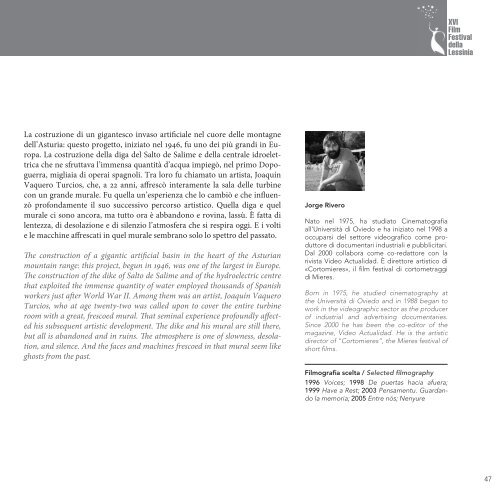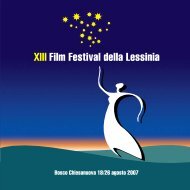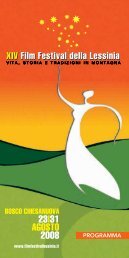2010 Interno Catalogo FFL.indd - Film Festival della Lessinia
2010 Interno Catalogo FFL.indd - Film Festival della Lessinia
2010 Interno Catalogo FFL.indd - Film Festival della Lessinia
You also want an ePaper? Increase the reach of your titles
YUMPU automatically turns print PDFs into web optimized ePapers that Google loves.
La costruzione di un gigantesco invaso artifi ciale nel cuore delle montagne<br />
dell’Asturia: questo progetto, iniziato nel 1946, fu uno dei più grandi in Europa.<br />
La costruzione <strong>della</strong> diga del Salto de Salime e <strong>della</strong> centrale idroelettrica<br />
che ne sfruttava l’immensa quantità d’acqua impiegò, nel primo Dopoguerra,<br />
migliaia di operai spagnoli. Tra loro fu chiamato un artista, Joaquín<br />
Vaquero Turcios, che, a 22 anni, aff rescò interamente la sala delle turbine<br />
con un grande murale. Fu quella un’esperienza che lo cambiò e che infl uenzò<br />
profondamente il suo successivo percorso artistico. Quella diga e quel<br />
murale ci sono ancora, ma tutto ora è abbandono e rovina, lassù. È fatta di<br />
lentezza, di desolazione e di silenzio l’atmosfera che si respira oggi. E i volti<br />
e le macchine aff rescati in quel murale sembrano solo lo spettro del passato.<br />
Th e construction of a gigantic artifi cial basin in the heart of the Asturian<br />
mountain range: this project, begun in 1946, was one of the largest in Europe.<br />
Th e construction of the dike of Salto de Salime and of the hydroelectric centre<br />
that exploited the immense quantity of water employed thousands of Spanish<br />
workers just aft er World War II. Among them was an artist, Joaquín Vaquero<br />
Turcios, who at age twenty-two was called upon to cover the entire turbine<br />
room with a great, frescoed mural. Th at seminal experience profoundly aff ected<br />
his subsequent artistic development. Th e dike and his mural are still there,<br />
but all is abandoned and in ruins. Th e atmosphere is one of slowness, desolation,<br />
and silence. And the faces and machines frescoed in that mural seem like<br />
ghosts from the past.<br />
Jorge Rivero<br />
Nato nel 1975, ha studiato Cinematografi a<br />
all’Università di Oviedo e ha iniziato nel 1998 a<br />
occuparsi del settore videografi co come produttore<br />
di documentari industriali e pubblicitari.<br />
Dal 2000 collabora come co-redattore con la<br />
rivista Video Actualidad. È direttore artistico di<br />
«Cortomieres», il fi lm festival di cortometraggi<br />
di Mieres.<br />
Born in 1975, he studied cinematography at<br />
the Università di Oviedo and in 1988 began to<br />
work in the videographic sector as the producer<br />
of industrial and advertising documentaries.<br />
Since 2000 he has been the co-editor of the<br />
magazine, Video Actualidad. He is the artistic<br />
director of “Cortomieres”, the Mieres festival of<br />
short fi lms.<br />
<strong>Film</strong>ografi a scelta / Selected fi lmography<br />
1996 Voices; 1998 De puertas hacia afuera;<br />
1999 Have a Rest; 2003 Pensamentu. Guardando<br />
la memoria; 2005 Entre nós; Nenyure<br />
XVI<br />
<strong>Film</strong><br />
<strong>Festival</strong><br />
<strong>della</strong><br />
<strong>Lessinia</strong><br />
47





